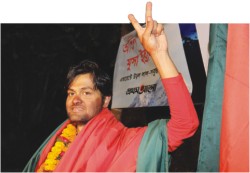
Musa Ibrahim
Pioneer Mountaineer
 Growing up around the Shyampur Sugar Mills in Rangpur, mountaineer Musa Ibrahim always found solace in the outdoors, his idol being Tarzan. As it would turn out, fate would take him to heights unseen by any Bangladeshi, as he conquered Mount Everest on May 23, 2010.
Growing up around the Shyampur Sugar Mills in Rangpur, mountaineer Musa Ibrahim always found solace in the outdoors, his idol being Tarzan. As it would turn out, fate would take him to heights unseen by any Bangladeshi, as he conquered Mount Everest on May 23, 2010.
On the outset, life seemed pretty normal and average for this pioneer, as he associated himself with journalism in 1999 while majoring in Science from Dhaka University. But right after graduation, Musa started chasing and conquering his dreams.. He started trekking in 2000 and climbed Bangladesh's highest hill, the Keocradong, in September. His career as a mountaineer started four years later when he traveled to the Himalayan Mountaineering Institute in Darjeeling for basic mountaineering training. He later completed advanced mountaineering training in 2005 to finish his course.
Musa prepared himself for the Everest by climbing the Himalayan Mountains from 2005, starting with the Mera peak to finally the Annapurna IV in 2009, thereby also becoming the first Bangladeshi to conquer a peak over 7000 meters,.
Musa's journey, however, did not end here.
“I do not believe that Everest is the end of my journey but the opening of my life long innings,” he says.
“My passion, now, is to work for children, to bring fun into the education system with the help of advanced technology; to bring more life to our planet through planting trees,” he adds.
Musa wants to plant as many trees in the country as the current population of Bangladesh. As such, he has started an initiative called the Everest Brigade.
“The Everest Brigade's target is to plant 160 million saplings a year -- the number of people in Bangladesh,” states Musa.
by Shahnoor Rabbani
Mashrafe Bin Mortaza
National Cricketer

His big-hearted endeavours on the field, aggressive intent and the prolonged injury catalogue may say otherwise, but Mashrafe Bin Mortaza is not an everyday fast bowler. A life full of experience has turned this firebrand into a man who is eager to give back without expecting much in return.
Mashrafe emerged as the leader of Bangladesh's bowlers in the early days of the country's test status. He made great strides under the tutelage of Andy Roberts, working on his stamina, and was given his first test cap against Zimbabwe in 2001. Since then, he has led the country in many a battle on the field after making heroic comebacks from persistent injuries to both legs.
His record speaks for itself, even with the limited number of matches he has played in international cricket so far -- in 36 Tests, he has 78 wickets while in ODIs, he has 151 wickets from 120 games. His latest spate has left him out of cricket for almost a year but the constant lay-offs have made Mashrafe a wiser man who doesn't take anything for granted.
Having played cricket ever since he was a teenager, the former national captain had to spend most of his life in Dhaka, though he loves his hometown of Narail more than anything else. The recent trend in the southern town has, however, left him a worried man, though he promises to soon find a way out of the mess.
“My childhood was spent in the fields whether playing cricket or football but these days, I don't see anyone in the fields,” he says, “I just think that the kids in Narail are too much into drugs.”
It is a sordid tale that Mashrafe tells. One youngster who used to be a talented cricketer took up arms as soon as drugs took a hold of him. “One day I hear that the boy who I knew played cricket murdered someone for just a few bucks. I think the parents, even in these small towns, should send their kids to the fields just so that they enjoy life and do not spend time watching television and larking about,” he said.
Mashrafe intends to set up cricket academies in Narail once he gets some time. He is known to have helped several boys from his hometown out of drugs, but he believes that saving a few won't make that much of a difference to the community.
As a cricketer and at his peak, he can be a match-winner, like when his 4-44 set up Bangladesh's maiden ODI win against New Zealand in 2008. That form prompted the IPL's Kolkata Knight Riders to sign him on for $600,000 in February 2009.
But as a man who believes that he has earned more money, name and fame than he had hoped for, Mashrafe wants to give back to Narail, his place of birth.
by Mohammad Isam
Saiman Miah
Official Coin Designer of the London 2012 Olympics
 Although tagged as a local of Britain, the fact that Saiman Miah -- the official coin designer of the London 2012 Olympics -- is a Bangladeshi is a source of immense pride for the country. Presently studying for his Masters degree at the Birmingham School of Architecture, this 24-year-old from Moseley in South Birmingham won the Royal Mint Competition for art and design students to come up with a commemorative coin for the upcoming London Games in the summer. His winning design is to be featured in the celebratory £5 coin of the Olympics.
Although tagged as a local of Britain, the fact that Saiman Miah -- the official coin designer of the London 2012 Olympics -- is a Bangladeshi is a source of immense pride for the country. Presently studying for his Masters degree at the Birmingham School of Architecture, this 24-year-old from Moseley in South Birmingham won the Royal Mint Competition for art and design students to come up with a commemorative coin for the upcoming London Games in the summer. His winning design is to be featured in the celebratory £5 coin of the Olympics.
His love of architecture drove him to take part in the design contest, which brought him success as well as the added delight of winning £5,000 prize money. Saiman Miah's interest in architecture grew during his secondary school education and after completing his Art Foundation course, he went on to pursue his long-cherished passion. The results came out life-sized.
The coin he designed features London's iconic skyline, comprising the London Eye, Big Ben, Westminster Abbey and St Paul's Cathedral on the bank of the River Thames in the centre and athletes engaged in their various disciplines along the edge.
Saiman's achievement is not just limited to winning the competition and getting the position of the official coin designer of the event he is now part of a British heritage and he has upheld Bangladesh's good name internationally. Winning such a special honour competing against a numbers of students across the UK is indeed a great accomplishment for a Bangladeshi.
by Saveem Shama